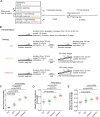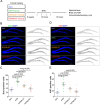Strength exercise weakens aerobic exercise-induced cognitive improvements in rats
- PMID: 30304037
- PMCID: PMC6179267
- DOI: 10.1371/journal.pone.0205562
Strength exercise weakens aerobic exercise-induced cognitive improvements in rats
Abstract
Aerobic exercise improves cognitive function and adult hippocampal neurogenesis. However, the effects of aerobic exercise combined with strength exercise on cognitive function and adult hippocampal neurogenesis are still unknown. In this study, we established exercise paradigms in rats to mimic aerobic exercise combined with low- and high-intensity strength exercise. We found that aerobic exercise improved spatial learning and memory as well as adult hippocampal neurogenesis, whereas strength exercise suppressed aerobic exercise-induced cognitive improvements and adult hippocampal neurogenesis in an intensity-dependent manner. Furthermore, the levels of β-hydroxybutyrate (β-HB) and its downstream effector brain-derived neurotrophic factor (BDNF) were increased in the aerobic exercise group, and strength exercise impaired the aerobic exercise-induced increases in β-HB and BDNF mRNA levels. Taken together, these results demonstrated that strength exercise weakened aerobic exercise-induced cognitive improvements and adult hippocampal neurogenesis in rats.
Conflict of interest statement
The authors have declared that no competing interests exist.
Figures




Similar articles
-
Physical exercise improves cognitive function by enhancing hippocampal neurogenesis and inhibiting apoptosis in male offspring born to obese mother.Behav Brain Res. 2018 Jul 16;347:360-367. doi: 10.1016/j.bbr.2018.03.018. Epub 2018 Mar 15. Behav Brain Res. 2018. PMID: 29551732
-
Exercise prevents IFN-α-induced mood and cognitive dysfunction and increases BDNF expression in the rat.Physiol Behav. 2017 Oct 1;179:377-383. doi: 10.1016/j.physbeh.2017.07.018. Epub 2017 Jul 12. Physiol Behav. 2017. PMID: 28711394
-
Strength and Aerobic Exercises Improve Spatial Memory in Aging Rats Through Stimulating Distinct Neuroplasticity Mechanisms.Mol Neurobiol. 2017 Dec;54(10):7928-7937. doi: 10.1007/s12035-016-0272-x. Epub 2016 Nov 22. Mol Neurobiol. 2017. PMID: 27878552
-
All about running: synaptic plasticity, growth factors and adult hippocampal neurogenesis.Curr Top Behav Neurosci. 2013;15:189-210. doi: 10.1007/7854_2012_220. Curr Top Behav Neurosci. 2013. PMID: 22847651 Free PMC article. Review.
-
Stress and adolescent hippocampal neurogenesis: diet and exercise as cognitive modulators.Transl Psychiatry. 2017 Apr 4;7(4):e1081. doi: 10.1038/tp.2017.48. Transl Psychiatry. 2017. PMID: 28375209 Free PMC article. Review.
Cited by
-
The Interaction Effect of Sleep Deprivation and Treadmill Exercise in Various Durations on Spatial Memory with Respect to the Oxidative Status of Rats.Neurochem Res. 2023 Jul;48(7):2077-2092. doi: 10.1007/s11064-023-03890-3. Epub 2023 Feb 14. Neurochem Res. 2023. PMID: 36786943
-
Revisiting the effects of exercise on cerebral neurovascular functions in rats using multimodal assessment techniques.iScience. 2023 Mar 9;26(4):106354. doi: 10.1016/j.isci.2023.106354. eCollection 2023 Apr 21. iScience. 2023. PMID: 37035001 Free PMC article.
-
Molecular Study of the Protective Effect of a Low-Carbohydrate, High-Fat Diet against Brain Insulin Resistance in an Animal Model of Metabolic Syndrome.Brain Sci. 2023 Sep 28;13(10):1383. doi: 10.3390/brainsci13101383. Brain Sci. 2023. PMID: 37891752 Free PMC article.
-
A Runner's High for New Neurons? Potential Role for Endorphins in Exercise Effects on Adult Neurogenesis.Biomolecules. 2021 Jul 21;11(8):1077. doi: 10.3390/biom11081077. Biomolecules. 2021. PMID: 34439743 Free PMC article. Review.
-
Complicated Role of Exercise in Modulating Memory: A Discussion of the Mechanisms Involved.Neurochem Res. 2022 Jun;47(6):1477-1490. doi: 10.1007/s11064-022-03552-w. Epub 2022 Feb 23. Neurochem Res. 2022. PMID: 35195832 Review.
References
-
- Brisswalter J, Collardeau M, René A. Effects of acute physical exercise characteristics on cognitive performance. Sports Medicine. 2002;32(9):555–66. - PubMed
Publication types
MeSH terms
Substances
LinkOut - more resources
Full Text Sources

